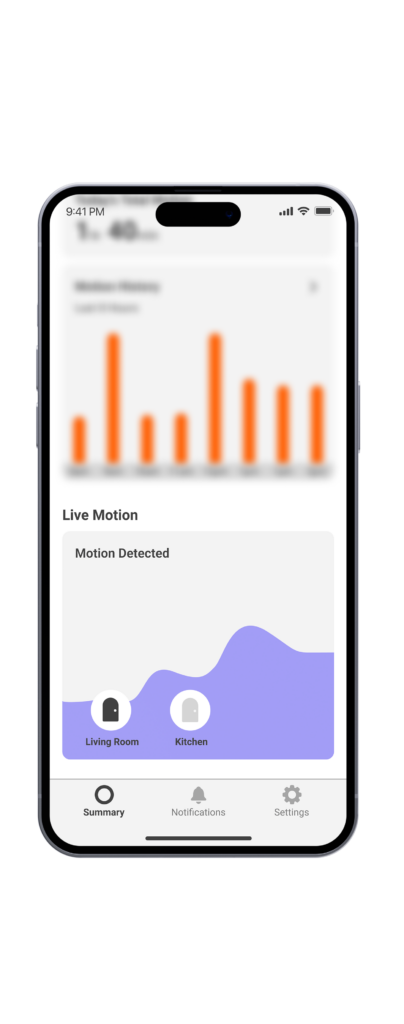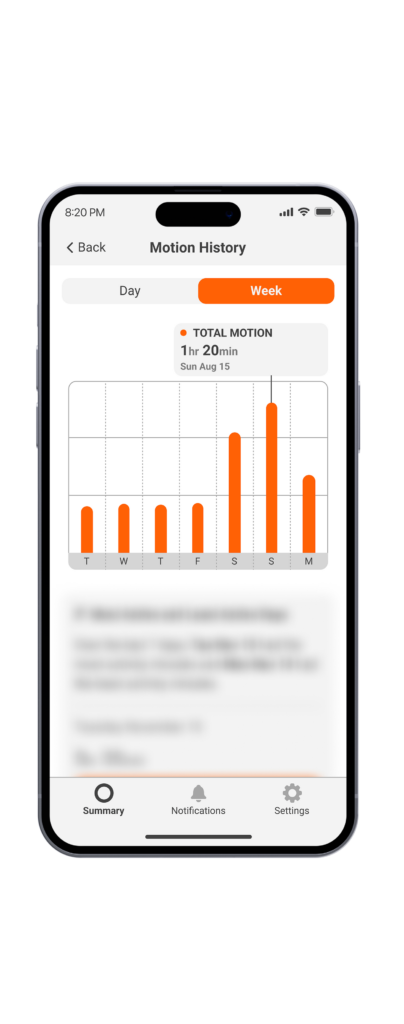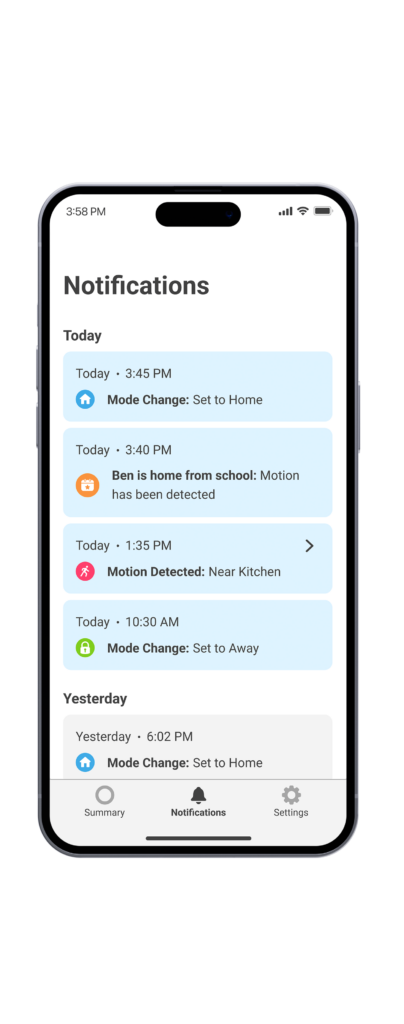WiFi Motion™ uses advanced algorithms and machine learning to turn simple motion sensing via Wi-Fi Sensing into a powerful tool for understanding and responding to movement in various environments. However, these insights are only helpful if users can see and understand them. To achieve this, WiFi Motion displays three types of motion:
- Live Motion: Real-time updates, allowing users to see and act on movement as it happens
- Historical Motion: Records and analyzes movement patterns over time, helping users identify trends and make informed decisions
- Event Motion: Captures specific significant motion events, providing detailed alerts and actionable insights such as location of motion
For end users, combining live, historical, and event motion means a deeper understanding of home motion patterns and effective responses to critical events. For developers, it allows fine-tuning systems and creating more responsive applications. Incorporating all three types of data in a Wi-Fi Sensing application ensures meaningful insights that truly provide value to the end user.
What is Live Motion?
Live motion data provides immediate, real-time information on detected movements, instantly processed and displayed in a dedicated portion of the app to offer quick insights like motion density (how much motion is occurring) and localization (where motion is occurring).

Note: This is a screenshot from a sample security monitoring mobile app
What is Live Motion Used For?
The main benefit of live motion data is that it helps validate the system’s operation. Users can instantly see if the system is detecting motion correctly which can provide peace of mind and aid in troubleshooting, testing, and initial setup. The real-time view also enhances user interaction and understanding, with engaging visuals making data more accessible and informative. This fosters a more interactive and satisfying user experience.
Live motion data is also essential for security monitoring, allowing homeowners to immediately check for motion and verify active alerts. This real-time insight ensures home safety, enabling quick action if needed. In eldercare, caregivers can instantly monitor motion in the homes of elderly loved ones, providing peace of mind. If no motion is detected, it may indicate a problem, prompting timely proactive check-ins.
What is Historical Motion?
Historical motion data shows movement patterns over time, whether over 24 hours, 7 days, or longer, enabling detailed analysis of trends and behaviors. This type of motion captures the ebb and flow of activity in a monitored environment so that users can form a comprehensive understanding of how motion changes over extended periods. Developer customizations can include graph representations of daily motion density, start and stop times, the number of motion instances, etc., making the data more digestible for users.

Note: This is a screenshot from a sample security monitoring mobile app
What is Historical Motion Used For?
Historical motion data is crucial for understanding daily routines and identifying behavioral changes. For example, users can monitor when family members leave and return home, establishing normal activity periods. These insights could optimize energy usage by adjusting heating and cooling when no one is home, reducing costs. Historical data also aids long-term security analysis. While daily changes may be hard to spot, long-term data can reveal unusual patterns, such as repeated late-night movements that could indicate potential security risks.
The more motion Wi-Fi Sensing analyzes in a space, the better it understands the patterns of the space and its inhabitants. With WiFi Motion’s advanced AI and ML algorithms, the system could be used to predict future behavior, enhancing proactive decision-making and improving efficiency. Understanding long-term patterns allows for personalized services as users gain deeper insights into behavior which in turn they can use to customize the settings and notifications within the app.
What is Event Motion?
Event motion is designed to provide detailed alerts and actionable insights from significant events, like intruder alerts, so that an end user can take immediate action. The Wi-Fi Sensing system detects specific instances of motion, triggered by actions like motion occurring when the system is armed. Unlike live data, which provides a real-time stream of motion and is only available when viewed live, event motion is recorded and stored for analysis and action. While motion history stores information such as state, intensity, or location, event motion focuses on the details of specific motion events.

Note: This is a screenshot from a sample security monitoring mobile app
What is Event Motion Used for?
Event motion’s key applications lie in its customization and flexibility for the end user. It enables users to tailor their system to respond dynamically based on specific sensing needs, notification preferences, and use cases. For example, users can enhance security by setting notifications for specific conditions, such as motion detected in a secured area after hours. In smart home systems, event motion could be leveraged to automate responses, such as adjusting the temperature when the system detects no motion for a set period, which improves energy efficiency and convenience. Event motion is also valuable for health monitoring, generating alerts for critical health-related events, such as prolonged inactivity, ensuring timely intervention and peace of mind.
For developers creating Wi-Fi Sensing applications, focusing on meaningful motion events is key to reducing false alarms. By allowing users to set their own notification preferences and thresholds for alerts, they will receive relevant notifications that lead to actionable responses, improving both their experience and the system’s effectiveness. This approach enhances precision, reduces noise, and highlights critical movements to ultimately boost system responsiveness and enable advanced analytics and personalization.
Three’s Not a Crowd
Integrating live, historical, and event motion creates a robust Wi-Fi Sensing system that delivers a complete view of motion activity. Each type of data—real-time insights from live motion, long-term trends from historical data, and specific alerts from event motion—complements the others to offer a comprehensive understanding of movement within a space. Incorporating all three types into a Wi-Fi Sensing solution gives users a fuller picture of motion in their homes, equipping them to handle any scenario that may arise. This combination not only enhances safety and security but also provides a versatile solution for various needs and use cases, making it an essential feature of an effective and responsive motion detection system.

